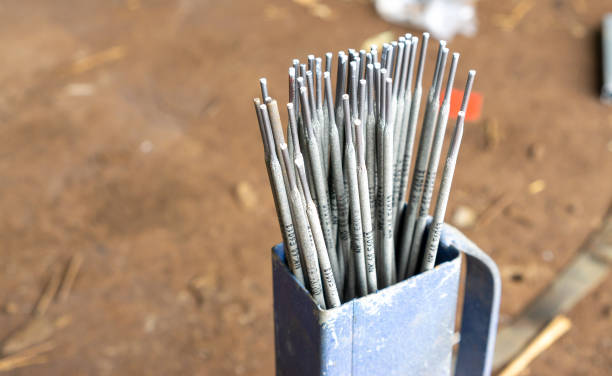When it comes to Shielded Metal Arc Welding (SMAW), ensuring the quality of your welds starts with the condition of your electrodes. Proper storage and redrying techniques are essential for keeping them in top shape, ultimately leading to high-quality welds. In this guide, we’ll break down the best practices for handling both low-hydrogen and non-low-hydrogen stick electrodes so you can avoid common issues like moisture absorption and cracking in your welds.

I. Why Proper Care for Electrodes Matters
Electrodes are crucial for welding, and if they’re not stored correctly, the environment can wreak havoc on their performance. Moisture is particularly problematic—it can lead to several issues, including:
Porosity: Moisture can cause gas pockets in the weld, resulting in porosity, which might only appear under advanced inspection.
Cracking: For low hydrogen electrodes, moisture can increase the risk of under-bead cracking, especially in high-strength steels.
Poor Arc Stability: Excess moisture can affect the arc characteristics, making it hard to achieve a consistent and clean weld.
Sticking to proper storage and redrying methods can prevent these issues and ensure your electrodes deliver great results every time.

II. Storing Low Hydrogen Stick Electrodes
Low hydrogen stick electrodes are especially sensitive to moisture, so they need careful handling and storage. Here are some straightforward tips to keep these electrodes in prime condition:
1. Keep Them in Sealed Containers
Unopened hermetically sealed containers are a great option for protecting low hydrogen electrodes from moisture. Store them in a dry environment to maintain their quality.
2. Use Heated Cabinets for Opened Containers
Once you’ve opened a can of low hydrogen electrodes, it’s critical to store them in a way that prevents moisture exposure. Heated cabinets set to a temperature range of 250°F to 300°F (120°C to 150°C) are ideal for keeping electrodes dry and ready for action.
3. Be Mindful of Exposure Times
The time low hydrogen electrodes can safely spend exposed to air varies. For standard EXX18 electrodes, it’s best to provide fresh supplies to welders twice a shift to limit moisture exposure. Moisture-resistant electrodes (marked with an “R” in their AWS classification) can handle longer exposure—up to about nine hours—without significant issues.
4. Check for Moisture Issues
Keep an eye on moisture levels, especially if electrodes have been in a humid environment. Be aware of these potential effects:
Mild Moisture: This can lead to hidden internal porosity, detectable only through advanced testing.
Moderate Moisture: Might show external porosity, rough surfaces, and increased slag fluidity in your welds.
Severe Moisture: Could cause significant cracking and excessive porosity within the weld.
III. Redrying Low Hydrogen Stick Electrodes
Redrying is a critical step to restore the effectiveness of low hydrogen electrodes that have picked up moisture. Here’s how to do it properly:
1. Stick to Recommended Temperatures
The ideal redrying temperature for low hydrogen electrodes is between 700°F and 800°F (370°C to 430°C). Avoid going higher than this, as excessive heat can damage the electrode coating and reduce its performance.
2. Timing is Key
Maintain the electrodes at the specified temperature for at least one hour. Prolonged drying at lower temperatures won't yield the same results.
3. Limit Redrying Cycles
For electrodes classified as E8018 or higher, redry them no more than three times to prevent oxidizing the coating, which could weaken tensile and impact properties.
4. Inspect for Damage
Before using redried electrodes, check them for any signs of damage. If the coating looks fragile or starts to flake, it's better to discard them to avoid compromising your weld quality.
5. Follow the Right Redrying Procedure
To redry low hydrogen electrodes:
Remove them from their containers.
Spread them out evenly in the drying oven to ensure each one reaches the right temperature.
Keep a close watch on the time to avoid overheating.
IV. Storing and Redrying Non-Low Hydrogen Electrodes
While non-low hydrogen electrodes are typically more resilient to moisture, they still need proper care. Here are some best practices for these kinds of electrodes:
1. Keep Them in Original Packaging
As long as they’re unopened, non-low hydrogen electrodes can maintain their moisture content indefinitely in a dry environment. Make sure to keep them sealed until you're ready to use them.
2. Handle Opened Containers with Care
Once the can is opened, non-low hydrogen electrodes can absorb moisture from the air. Store them in a heated cabinet at temperatures between 100°F and 120°F (40°C to 50°C) to prevent moisture buildup if they’re likely to be exposed for longer periods.
3. Assess the Need for Redrying
If you suspect moisture contamination, non-low hydrogen electrodes can be redried using the following guidelines:
4. Inspect After Redrying
Just like low hydrogen electrodes, check non-low hydrogen electrodes for signs of damage after redrying. If they show any deterioration, it’s best to dispose of them.
V. Conclusion
Proper care for welding electrodes is essential for achieving high-quality welds and ensuring efficient welding operations. By following the practices outlined in this guide, you can keep your electrodes in great shape, reducing the risk of defects and enhancing the overall quality of your work.
Investing time in electrode care pays off with superior welds, fewer issues, and a boost in productivity. Whether you’re working with low hydrogen or non-low hydrogen stick electrodes, sticking to these best practices will ensure that you’re consistently delivering top-notch results in your projects.
Remember, successful welding relies not just on the welder's skill but also on the quality and condition of the materials used. So take the time to properly store and redry your electrodes—they’ll thank you with better performance on the job!
Related articles:
1. A Guide to Arc Welding Electrodes
2. Tungsten Electrodes Basics: Types, Pros & Cons, Selection, Maintenance
3. How to Identify and Solve Tungsten Electrode and Arc Issues
4. How To Shape Tungsten Electrode For TIG Welding?
5. Stick Welding Electrode Selection & Techniques Guide





